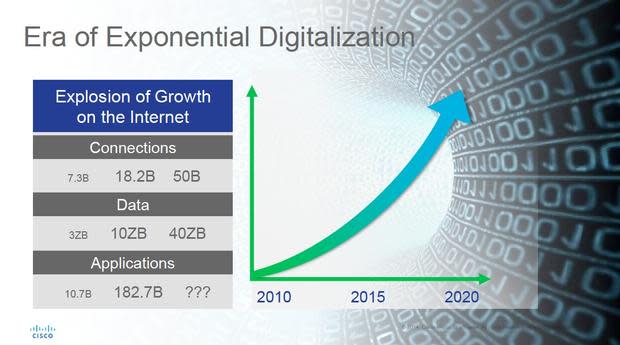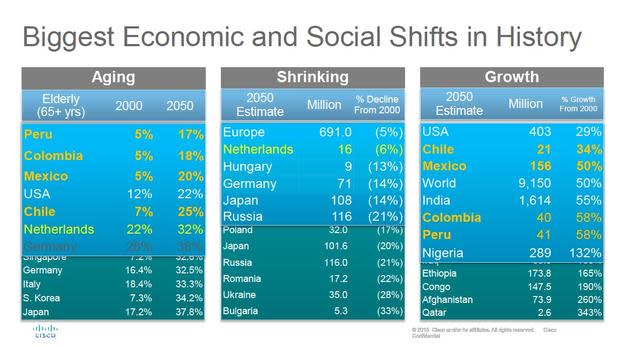Cisco: The Internet of Everything is at tipping point

Wim Elfrink, EVP for Cisco, talks about IoE and IOT at a Miami forum
Image: Teena Hammond/TechRepublic
The Internet of Everything (IoE), the digitization of business and society, is at the tipping point where future growth will happen at an astronomical rate, according to Wim Elfrink, executive vice president of industry solutions and chief globalization for Cisco.
"Major trends are reshaping the global landscape," Elfrink said at Cisco's IoE and IoT regional forum in Miami on Tuesday.
IoE includes the Internet of Things (IoT). Elfrink explained that the evolution of the internet has been a four-stage process thus far. It began with basic connectivity, then moved to a networked economy, then immersive experiences, and is now at the fourth stage, which is IoE.
"Now we move in the next decade what we call the Internet of Everything. Where we connection people, processes, the data that you can monetize that you can change business. The biggest impact will be the process that we engineer. LOBS (lines of business) in companies can basically buy the services they want in a company," Elfrink said.
The tipping point
Proof of the tipping point of IoE is apparent in the amount of internet connections being used around the world and the amount of data being transmitted.

The growth of IoE and IoT
Image: Cisco
There are currently 18.2 billion connections to the internet throughout the world, and this will increase to 50 billion by 2020. The amount of data being transmitted via these connections has grown from 3ZB (3,000,000,000,000,000,000,000 bytes) in 2010 to 10ZB (10,000,000,000,000,000,000,000 bytes) this year, and it is predicted to reach 40ZB (40,000,000,000,000,000,000,000 bytes) by 2020, according to Elfrink.
IoE has the potential to reach $19 trillion of value by 2022, and it "has the potential to grow global corporate profits by 21% in 2022," Elfrink said. "It's exponentially increasing."
Opportunity for the enterprise
By reaching the tipping point, it means that there is a greater need for organizations to have a chief data or digitization officer to create the end-to-end analytics needed to transform data into actionable intelligence, he said.
"What are we going to do with all that data? Fortunately now we have applications," he said. "Think about traffic and congestion and how can you use data for future solutions. We're basically moving to a data-driven world. You will hear a lot in society who owns the data, who secures the data. I'm part of the board of a healthcare company. They make medical devices, for instance, a pacemaker. The company who makes the pacemaker says, 'it's my data.' The patient says, 'no, no, no, no, it's my data.' The insurance company says, 'I pay for this.'"
It's not clear yet who owns the data, he said. "Lawyers will make a lot of money. We have to sort out who owns the data. There is an enormous opportunity... monetization of data."
"We estimate that in the US alone over the last year almost 300,000 jobs have been created in the apps world," Elfrink said. "The world is moving to an app based world and it will dramatically change the way we do business.
"In Silicon Valley this year is predicted to be the biggest IPO year in history. It's much easier to start a business. You have world-wide access, global access to data, and it will stimulate economies that embrace these concepts."
An aging society
The aging global society is one of the reasons why IoE is essential, to enable people to live alone, without assistance, for longer, Elfrink said.

The world's population is aging and shrinking
Image: Cisco
In some countries, the population is predicted to shrink by 2050, as the global existing population ages. In the US, 12% of the population was 65 years old or more in 2000. In 2050, 22% of the population will fit into this age demographic. In Europe, there are predicted to be 691 million people in 2050, down 5% from 2000.
The main challenges include, "How do you give people access to healthcare and education and create jobs," Elfrink said.
"We position technology not as an objective but as an enabler to address these types of issues. It's going to be the virtualization of the workforce. We position technology as a key enabler. The Internet of Everything."
Read more about IoE and IoT:
Experts: Wearables market to be driven by fashion, big data, IoT and security concerns
Paralyzed driver exceeds 100 mph at Indy thanks to IoT technology
Four takeaways from Deloitte's 2015 technology trends report

